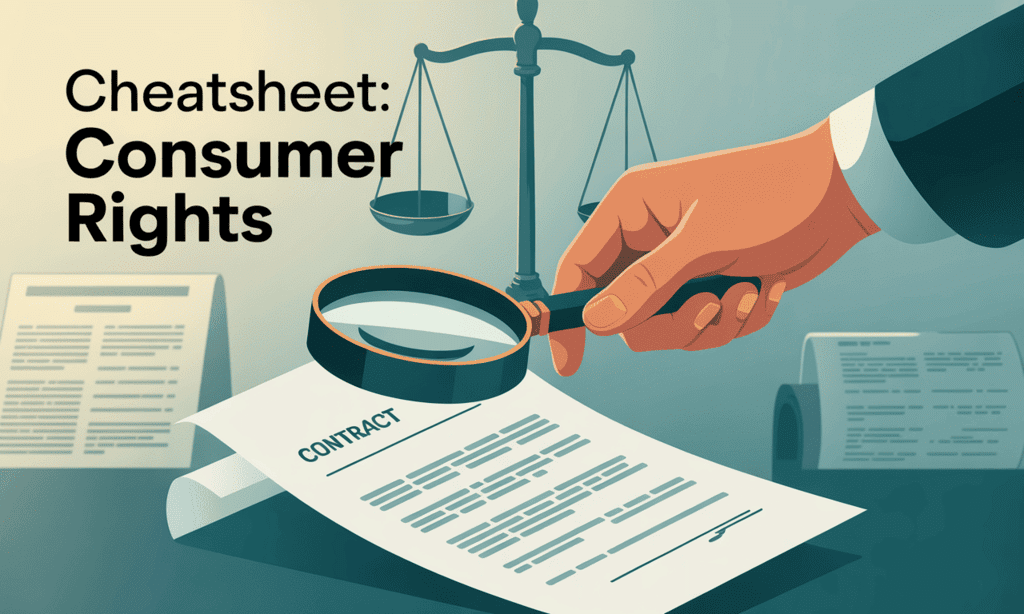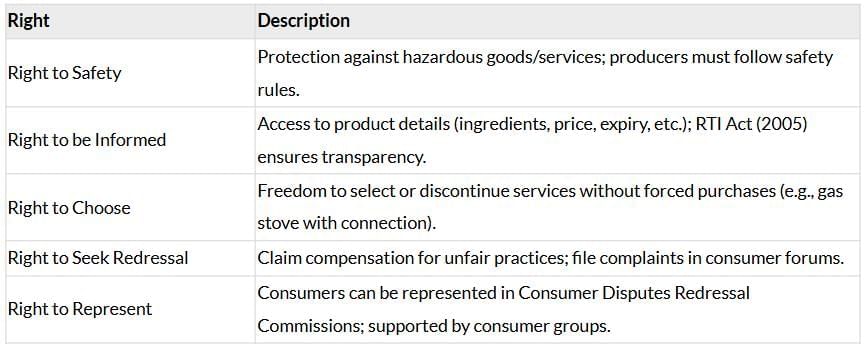Class 10 Exam > Class 10 Notes > Social Studies (SST) Class 10 > Cheatsheet: Consumer Rights
Cheatsheet: Consumer Rights | Social Studies (SST) Class 10 PDF Download
| Table of contents |

|
| Consumer in the Marketplace |

|
| Consumer Movement |

|
| Consumer Rights |

|
| Consumer Disputes Redressal System (COPRA) |

|
| Taking the Consumer Movement Forward |

|

Consumer in the Marketplace
Roles: People act as producers (create goods/services) and consumers (buy goods/services).
Need for Regulation:- Protect unorganized sector workers from low wages, poor conditions.
- Prevent exploitation by moneylenders (e.g., forcing farmers to sell produce cheaply).
- Safeguard the environment.
Exploitation Examples: Small farmers (e.g., Swapna) sell land to repay loans; workers face health risks, unfair wages.
Consumer Protection: Rules needed to address unfair trade practices; consumer movement strengthens rights.
Consumer Movement
- Origin: Started in 1960s due to food shortages, hoarding, black marketing, and adulteration.
- Early Efforts (1960s-70s): Consumer groups wrote articles, held exhibitions, addressed malpractices in ration shops and transport overcrowding.
- Current Status: Over 2000 consumer groups in India, with 50-60 well-recognized.
- Exploitative Practices: Underweighing, hidden charges, selling adulterated/defective goods.
Consumer Rights

Examples: Replace defective products within expiry date; expired medicines face strict action. MRP prevents overpricing; consumers can negotiate lower prices.
Consumer Disputes Redressal System (COPRA)
- Process: Consumers can appeal from district to state to national level.
- Support: Consumer forums, protection councils, and Residents’ Welfare Associations assist with filing cases.
- Funding: Government supports consumer groups for awareness.
Taking the Consumer Movement Forward
- National Consumers’ Day: 24 December (COPRA enacted in 1986).
- COPRA 2019: Strengthens rights for online purchases, holds service providers accountable.
- Mediation: Encouraged at all commission levels for dispute resolution.
- Redressal process is time-consuming, costly, requires lawyers/proof.
- Slow consumer awareness growth.
- Weak enforcement for unorganized sector workers.
Solution: Active consumer participation and voluntary efforts needed for stronger movement.
The document Cheatsheet: Consumer Rights | Social Studies (SST) Class 10 is a part of the Class 10 Course Social Studies (SST) Class 10.
All you need of Class 10 at this link: Class 10
|
66 videos|614 docs|79 tests
|
FAQs on Cheatsheet: Consumer Rights - Social Studies (SST) Class 10
| 1. What is the significance of the Consumer Movement in protecting consumer rights? |  |
Ans. The Consumer Movement is significant as it aims to create awareness among consumers about their rights and the importance of making informed choices. It encourages individuals to advocate for their interests and seek justice in cases of exploitation or unfair practices. By mobilizing consumers, the movement plays a crucial role in promoting transparency, accountability, and fairness in the marketplace.
| 2. What are the fundamental rights of consumers under the Consumer Protection Act? |  |
Ans. The fundamental rights of consumers under the Consumer Protection Act include the right to safety, the right to be informed, the right to choose, the right to be heard, and the right to seek redressal. These rights empower consumers to make safe choices, access necessary information, select from a variety of products, voice their concerns, and obtain compensation for grievances, thus ensuring a fair market environment.
| 3. How does the Consumer Disputes Redressal System (COPRA) function? |  |
Ans. The Consumer Disputes Redressal System, established under COPRA, functions through a three-tier mechanism comprising District Forums, State Commissions, and the National Commission. Consumers can file complaints regarding unfair trade practices, defective goods, or inadequate services at these forums. Each level addresses grievances, with the National Commission serving as the highest authority for appeals, ensuring timely and effective resolution of consumer disputes.
| 4. What steps can consumers take to further the Consumer Movement? |  |
Ans. Consumers can further the Consumer Movement by actively participating in awareness campaigns, joining consumer organizations, and sharing their experiences regarding products and services. They can also educate others about their rights, advocate for better regulations, and report unethical practices to authorities. By collectively voicing their concerns, consumers can influence policies and promote a fairer marketplace.
| 5. Why is it important for consumers to be aware of their rights and the mechanisms available for redressal? |  |
Ans. It is important for consumers to be aware of their rights and the mechanisms available for redressal because knowledge empowers them to protect themselves against exploitation. Awareness enables consumers to identify unfair practices, seek help in resolving disputes, and assert their rights effectively. Understanding these mechanisms also encourages more people to report grievances, leading to improved standards in goods and services and promoting accountability among businesses.
Related Searches




















